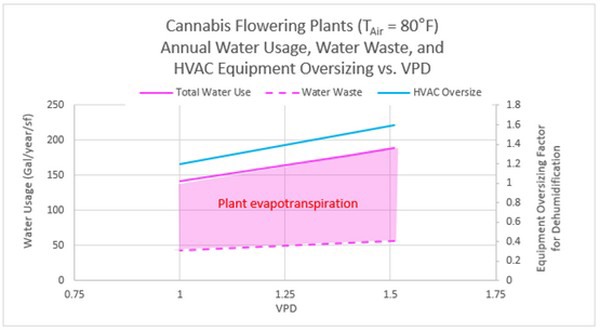Vapor pressure deficit (VPD) represents the 'pressure' that air puts on the plant to transpire and move air from the roots through the plant and out the stomata in their leaves. When the air is dry (low humidity) and the VPD is high, there will be more pressure on the plant to transpire and keep up with the higher rate of evaporation from the stomata. When the air is humid and the VPD is low, there will be less pressure on the plant to transpire. If plants are not well-watered under high VPD levels, then they may begin to wilt. Additionally, if the transpiration rate is really fast, then plants may not be able to move nutrients effectively to the various parts of the plants. Calcium deficiency is the most common abiotic symptom of really high transpiration rates and can be observed as leaf tip burn in lettuces and blossom end rot in tomatoes.
For most horticultural crops, a VPD = 1.0 kPa (10 bar) is a good target to grow healthy and productive plants. Growers can determine the VPD in their room by using their existing air temperature and humidity sensors. For every Temp/RH combo, there is an associated vapor pressure. The saturation vapor pressure can be determined for that same temperature, assuming 100% relative humidity.
The VPD also affects HVAC equipment selection and operation. For a given room temperature, lower relative humidity levels (high VPD) will make the HVAC equipment work harder to remove the water vapor transpired by the plant. This high VPD may also require larger HVAC equipment with higher latent cooling (dehumidification) capacities to prevent the humidity from climbing. Lower room temperature targets combined with low relative humidity can increase the HVAC needs even more. And because these high VPDs increase plant transpiration, more irrigation water will be required to prevent wilting.
Below is an example of how VPD can affect water utilization rates and HVAC capacities. The top solid line represents the annual irrigation volume to the crop and the bottom dashed line represents an average 30% drainage rate. The space in between is the volume of water taken up by the plant, the majority of which is transpired into the room as water vapor.
 Assumptions: LED Lights, 30% drainage, HVAC SHR = 0.5
Assumptions: LED Lights, 30% drainage, HVAC SHR = 0.5
For flowering cannabis plants there is an estimated 30% increase in the total annual water use between a VPD of 1.0 and 1.5 kPa. Not only does this affect the water requirements for irrigation, it also affects consumable costs for nutrients, the potential environmental impact of the drain-to-waste systems, and the need for water treatment both for reuse and before sending to the sewer. The HVAC capacity needed to meet the dehumidification load at a VPD of 1.5 kPa is about 25% greater than at 1.0 kPa, requiring both larger equipment and more energy to operate it.
Understanding VPD and its impact on plant development, HVAC selection, and resource utilization is essential for the grower to optimize yields and costs. When the right VPD is targeted for the given crop, light source, and nutrient/water delivery methods, the right HVAC equipment can be installed to manage the room conditions, while minimizing capital and operating costs, and ultimately, maximizing plant growth and health.
For more information:
Doctor Greenhouse
www.doctorgreenhouse.com
